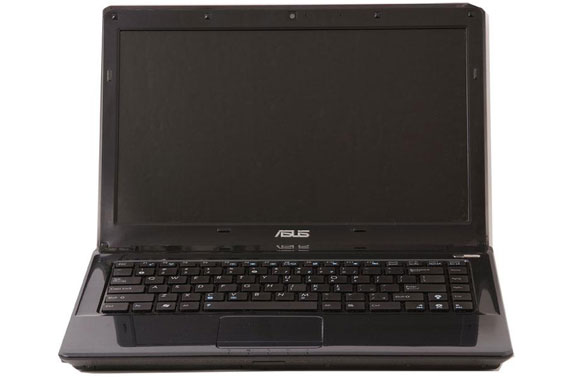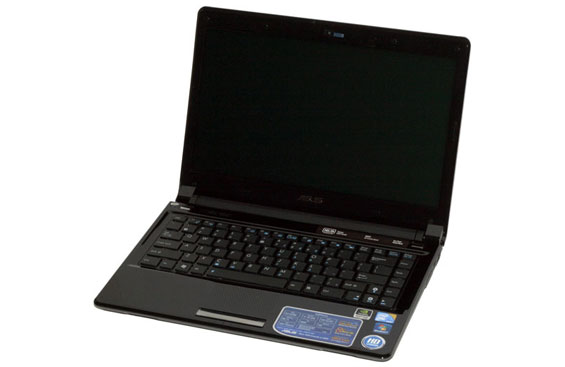Mobile Buyers' Guide: 14" and Larger Notebooks and DTRs
by Dustin Sklavos on June 30, 2010 12:53 AM EST
Portable Notebook: ASUS K42J
We'll start by horning in on a little bit of Vivek's territory: choosing a portable powerhouse. ASUS actually has a healthy history of producing 14-inch notebooks with performance characteristics that frankly shame their larger kin. Yours truly has owned two of these beasts (an A8Jm and an X83) and can attest to their quality and performance. Midrange graphics in a 14-inch machine? Yes please.

Our pick for the most portable performance machine goes to the ASUS K42JV-X1, available at Newegg for the princely sum of $949. This tiny terror comes equipped with an Intel Core i5-450M running at a nominal 2.4 GHz clock speed on both cores (2.66GHz with Turbo), 4GB of DDR3 RAM, a 500GB 7200RPM hard drive, and a GeForce GT 335M with 1GB of DDR3 video memory. The GT 335M is equivalent to the desktop GeForce GT 240, but with a reduced shader count (72 instead of 96) and the lowered clocks that are par for the course for mobile graphics.
While we don't have hands on experience with this particular model, its predecessors have been traditionally reliable and popular machines that have offered middling battery life but outstanding overall performance. The low resolution screen (1366x768) and lack of ExpressCard or FireWire make the K42 a tough sell for multimedia work, but for raw performance and portability it's a very tough nut to crack.
Portable Runners Up: ASUS UL80Vt and Alienware M11x

The K42 may use more full-bodied, luscious mainstream processors, but if you demand greater portability you'll be looking toward notebooks utilizing Intel's CULV platform. In that instance, the 14-inch UL80Vt line certainly fits the bill. It's last generation in every sense, using a Core 2 Duo and switchable GeForce G 210M instead of a modern Core 2010 chip and Optimus-enabled NVIDIA hardware, but it's reviewed well and you can pick it up for $700 these days. The UL50Vf was essentially the same system but with a 15.6" chassis and Optimus, but the 14" model was far more interesting. Odds are ASUS has a refresh of this notebook on the way, so it may not hurt to hold out and see what shakes loose. Other alternatives from ASUS include the UL30Jc—it's a 13.3" unit that packs a much more potent CPU, though the GPU isn't at the same level as the K42.

If you want to go simultaneously smaller and bigger, the Alienware M11x is universally beloved even by reviewers that ordinarily hate gaudy Alienware machines (such as yours truly.) With the M11x, Alienware produced something no one else had: an authentic gaming netbook. This one horns in on Vivek's territory, too, but if you're of the belief that more of less is more and are willing to take the hit to processor power, the M11x makes a convincing case as an alternative to the very similarly equipped K42. The original M11x used switchable graphics with an overclocked Core 2 SU7300, similar to the UL80Vt; an updated model with Arrandale ULV and Optimus is now available on Alienware's site—we're still waiting for our review model, but there's no reason the new unit shouldn't surpass the original in every important metric.
Frankly, we'd like to see more Optimus laptops with reasonable GPUs (like the K42Jv above—why doesn't it have Optimus?), but most of those will fall into the ultraportable category so we'll save further discussion for next week. The U30Jc had all the goods but still needs more than a 310M if you want gaming performance. The M11x refresh looks to be the most potent Optimus laptop out there right now, which is why we had to make room for it even if this isn't the ultraportable guide.










63 Comments
View All Comments
MedX91 - Wednesday, June 30, 2010 - link
Fortunately AT does focus on other rigs than mainstream ones. Just got totally frustrated with a 1400$-Machine from Dell (Latitude 6410) which is poorly assembled, with grabs on the display and other lapsi as well. Never ever again.mele - Wednesday, June 30, 2010 - link
While I realize that things like design and looks are very subjective. I can't help but find almost all of the mentioned laptops downright ugly. Some are not that bad, but if Im spending a 1000 or more dollar on a piece of machinery I want it to look and feel good too.Below are just a few things I'd like manufacturers to pay more attention to:
- Plastic usually feels cheap.
- A form factor that does justice to the term portable (and yes, even a 15 or 17 inch laptop, doesn't have to feel chunky)
- Already mentioned above - Screen quality does matter!
- Battery life - while I personally don't need 10 or even 14 hours, it's ridiculous that many average performing laptops still can't top 2,5-3 hours while in use.
- You shouldn't have to struggle to work with a trackpad.
- Hinges shouldn't break or crack while they do the thing there are made for...
- Be conservative when putting in (blinking) lights. They should never be a distraction.
- in case of doubt: simplicity usually gets the job done!
I have high hopes for the new Envy 14, as it might be one of the first laptops that combine Macbook good looks with powerful components for an attractive price. I just wish more manufactures would care about their design. The outside of the laptop should be more than just the box you put stuff in.
Dustin Sklavos - Wednesday, June 30, 2010 - link
I don't totally disagree and it seems like a lot of changes in the industry have almost nothing to do with customer feedback (16:9 aspect displays, I'm looking at you).I do take issue with expecting amazing battery life out of an 8 pound land monster, though. About the only really powerful machine I know of that gets good battery life is the Dell Studio 17; with the 9-cell battery it pushes more than four hours. This is the exception, not the rule.
And frankly, if you're going to be spending up on a performance laptop, you need to weigh costs of components, etc. The notebook market is nicely cutthroat; many manufacturers hit their low prices by using cheaper shells and they do have to cut some corners. If you want great battery life, great portability, and great looks, expect to pay for it with a business-class notebook. Prices generally really are where they ought to be for what you get.
mele - Wednesday, June 30, 2010 - link
I think that perhaps I wasn't clear enough. Please allow me to clarify.I have no trouble with high performance, or otherwise beast-like machines having a battery life of 30 minutes or on the other side of the spectrum, machines with 10+ hours of battery life that perform like a high-end smartphone. However I do feel that the balance between battery life and performance is off. It feels like the middle segment performance wise is nowhere near the middle in battery life. All I'm saying is that between 3.5 and 5 hours of battery life (which is not like, outrageous imo) on a middle off the road laptop should be much more common than it is now.
As for the other part. Of course I realize that great battery life, great portability and great looks are gonna cost more. Combine it with good performance and you're going to have to fork over a boatload of money. That's the fine. However, I do feel, as with performance vs. battery life, that the balance between specifications and other important qualities of a laptop (like design, chunky-ness, built quality etc..) is off.
It is in my experience these qualities get more value to people over laptop purchases (time), since they just didn't realize the 'other stuff' is important too.
GSJ - Wednesday, June 30, 2010 - link
This notebook was mentioned in the U30jc article. Google search does confirm the existence of such a notebook. Some Asus articles from Taiwan mentions it's spec.It is basically same as K42J mentioned in this article but with USB 3.0 and non-glossy finish.
Any info on when this notebook will be launched in US.
Axbattler - Wednesday, June 30, 2010 - link
It would have been useful to include the weight of the various laptop mentioned. Granted that at 14, and especially 15" and beyond, weight might be secondary to some. However, the lighter 14" can also be not too far from the heavier 13", which I consider quite ideal for frequent travels, while more likely to have better GFX cards.Another thing that would be nice to mention is connectivity. ExpressCard and FireWire aside, the presence of eSATA is handy, especially if it is going to act as desktop replacement. While they are getting more common, they still can't be taken for granted.
fabarati - Wednesday, June 30, 2010 - link
My mother was in the market for a new laptop, 15"-ish, with HDMI. Basic performance, etc. After much looking, I settled for the then brand new, not reviewed yet Dell Vostro 3500. I went for what was the cheapest one, with a core i3-330m and igp. Only extra was changing the colour to red. It turned out to be a really good laptop. And cheap too!teohhanhui - Wednesday, June 30, 2010 - link
I ordered the Dell Vostro 3400 (red as well). Can't wait for it to arrive.jgrunhut - Wednesday, June 30, 2010 - link
I'm on my second Vostro 3400. Absolutely love it, except for an irritating fan noise issue (still waiting to be fixed via a simple BIOS update).One of the cheapest thinnish (<1.2 in) laptops I have seen to date (only paid $619 CDN for i3 350, 3 GB RAM, 320 GB HD, intel Core graphics).
It would be great if Anandtech could review one of the new Vostro 3000 series laptops... especially if you could use your muscle to get Dell to hurry up and fix this fan issue ;)
fokka - Wednesday, June 30, 2010 - link
so was my mother in law, ordered her the cheapest vostro 3300 with 3 years warranty. great little sucker.